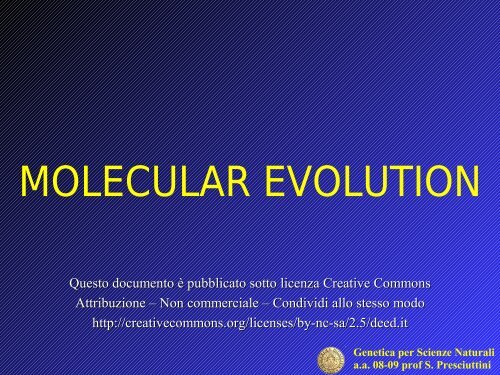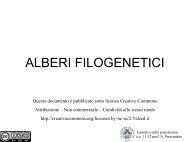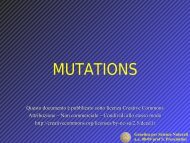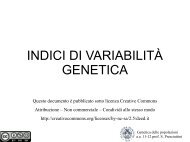MOLECULAR EVOLUTION
MOLECULAR EVOLUTION
MOLECULAR EVOLUTION
Create successful ePaper yourself
Turn your PDF publications into a flip-book with our unique Google optimized e-Paper software.
<strong>MOLECULAR</strong> <strong>EVOLUTION</strong><br />
Questo documento è pubblicato sotto licenza Creative Commons<br />
Attribuzione – Non commerciale – Condividi allo stesso modo<br />
http://creativecommons.org/licenses/by-nc-sa/2.5/deed.it<br />
Genetica per Scienze Naturali<br />
a.a. 08-09 prof S. Presciuttini
1. Homologous genes<br />
Genes with similar functions can be found in a diverse range of living<br />
things.<br />
The great revelation of the past 20 years has been the discovery that<br />
the actual nucleotide sequences of many genes are sufficiently well<br />
conserved that homologous genes—that is, genes that are similar in<br />
their nucleotide sequence because of a common ancestry—can often<br />
be recognized across vast phylogenetic distances.<br />
For example, unmistakable homologs of many human genes are easy<br />
to detect in such organisms as nematode worms, fruit flies, yeasts, and<br />
even bacteria.<br />
Genetica per Scienze Naturali<br />
a.a. 08-09 prof S. Presciuttini
2. Similarity of nucleotide sequences<br />
Homologous genes are ones that share a common evolutionary<br />
ancestor, revealed by sequence similarities between the genes. These<br />
similarities form the data on which molecular phylogenies are based.<br />
Homologous genes fall into two categories:<br />
<br />
<br />
Orthologous genes are those homologs that are present in different organisms<br />
and whose common ancestor predates the split between the species.<br />
Paralogous genes are present in the same organism, often members of a<br />
recognized multigene family, their common ancestor possibly or possibly not<br />
predating the species in which the genes are now found.<br />
A pair of homologous genes do not usually have identical nucleotide<br />
sequences, because the two genes undergo different random changes<br />
by mutation, but they have similar sequences because these random<br />
changes have operated on the same starting sequence, the common<br />
ancestral gene.<br />
Two DNA sequences with 80% sequence identity<br />
Genetica per Scienze Naturali<br />
a.a. 08-09 prof S. Presciuttini
3. Reconstructing extinct gene sequences<br />
For closely related organisms such as humans and chimpanzees, it is<br />
possible to reconstruct the gene sequences of the extinct, last common<br />
ancestor of the two species.<br />
The close similarity between human and chimpanzee genes is mainly<br />
due to the short time that has been available for the accumulation of<br />
mutations in the two diverging lineages, rather than to functional<br />
constraints that have kept the sequences the same.<br />
Evidence for this view comes from the observation that even DNA<br />
sequences whose nucleotide order is functionally unconstrained —<br />
such as the third position of “synonymous” codons — are nearly<br />
identical.<br />
Genetica per Scienze Naturali<br />
a.a. 08-09 prof S. Presciuttini
4. Human and chimpanzee leptin genes<br />
Leptin is a hormone that regulates food intake and energy utilization in<br />
response to the adequacy of fat reserves.<br />
For convenience, only the first 300<br />
nucleotides of the leptin coding<br />
sequences are given.<br />
Only 5 codons (of 441 nucleotides<br />
total) differ between these two<br />
sequences, and in only one does the<br />
encoded amino acid differ. The<br />
corresponding sequence in the<br />
gorilla is also indicated. In two<br />
cases, the gorilla sequence agrees<br />
with the human sequence, while in<br />
three cases it agrees with the<br />
chimpanzee sequence.<br />
Genetica per Scienze Naturali<br />
a.a. 08-09 prof S. Presciuttini
5. The ancestor sequence<br />
What was the sequence of the leptin gene in the last common ancestor<br />
of human and chimpanzee?<br />
We know from other evidences that human and chimpanzee are more<br />
closely related one to each other than any of them to gorilla<br />
An evolutionary model that seeks to minimize the number of<br />
mutations postulated to have occurred during the evolution of the<br />
human and chimpanzee genes would assume that the leptin sequence<br />
of the last common ancestor was the same as the human and<br />
chimpanzee sequences when they agree<br />
When they disagree, it would use the gorilla sequence as a tie-breaker.<br />
Therefore, the sequence of the common ancestor underwent three<br />
substitutions (at position 2, 4 and 5 of the five differences) in the<br />
human lineage, and two substitutions (at positions 1 and 3) in the<br />
chimpanzee lineage<br />
Genetica per Scienze Naturali<br />
a.a. 08-09 prof S. Presciuttini
6. Which individual’s DNA have to be compared?<br />
<br />
<br />
In comparisons between two species that have diverged from one<br />
another by millions of years, it makes little difference which<br />
individuals from each species are compared.<br />
<br />
For example, typical human and chimpanzee DNA sequences differ from one<br />
another by 1%. In contrast, when the same region of the genome is sampled<br />
from two different humans, the differences are typically less than 0.1%. For<br />
more distantly related organisms, the inter-species differences overshadow<br />
intra-species variation even more dramatically.<br />
However, each “fixed difference” between the human and the<br />
chimpanzee (i.e., each difference that is now characteristic of all or<br />
nearly all individuals of each species) started out as a new mutation in<br />
a single individual. How does such a rare mutation become fixed in<br />
the population, and hence become a characteristic of the species rather<br />
than of a particular individual genome?<br />
Genetica per Scienze Naturali<br />
a.a. 08-09 prof S. Presciuttini
7. A mosaic of small DNA pieces<br />
The answer to the previous question depends on the functional<br />
consequences of the mutation. If the mutation has a significantly<br />
deleterious effect, it will simply be eliminated by purifying selection<br />
and will not become fixed. (In the most extreme case, the individual<br />
carrying the mutation will die without producing progeny.)<br />
Conversely, the rare mutations that confer a major reproductive<br />
advantage on individuals who inherit them will spread rapidly in the<br />
population. Because humans reproduce sexually and genetic<br />
recombination occurs each time a gamete is formed, the genome of<br />
each individual who has inherited the mutation will be a unique<br />
recombinational mosaic of segments inherited from a large number of<br />
ancestors.<br />
The selected mutation along with a modest amount of neighboring<br />
sequence — ultimately inherited from the individual in which the<br />
mutation occurred — will simply be one piece of this huge mosaic.<br />
Genetica per Scienze Naturali<br />
a.a. 08-09 prof S. Presciuttini
8. Functional Constraint<br />
Changes to genes that diminish an organism's ability to survive and<br />
reproduce are typically removed from the gene pool by the process of<br />
natural selection.<br />
Portions of genes that are especially important are said to be under<br />
functional constraint and tend to accumulate changes very slowly over<br />
the course of evolution.<br />
Different portions of genes do accumulate changes at widely differing<br />
rates that reflect the extent to which they are functionally constrained.<br />
Changes at the nucleotide level of coding sequence that do not change<br />
the amino acid sequence of a protein are called synonymous<br />
substitutions.<br />
In contrast, changes at the nucleotide level of coding sequence that do<br />
change the amino acid sequence of a protein are called nonsynonymous<br />
substitutions.<br />
Genetica per Scienze Naturali<br />
a.a. 08-09 prof S. Presciuttini
9. The molecular clock<br />
The integrated phylogenetic trees support the basic idea that changes<br />
in the sequences of particular genes or proteins occur at a constant<br />
rate, at least in the lineages of organisms whose generation times and<br />
overall biological characteristics are quite similar to one another.<br />
This apparent constancy in the rates at which sequences change is<br />
referred to as the molecular-clock hypothesis.<br />
Molecular clocks have a finer time resolution than the fossil record<br />
and are a more reliable guide to the detailed structure of phylogenetic<br />
trees than are classical methods of tree construction, which are based<br />
on comparisons of the morphology and development of different<br />
species. For example, the precise relationship among the great-ape<br />
and human lineages was not settled until sufficient molecularsequence<br />
data accumulated in the 1980s to produce the tree that was<br />
shown<br />
Genetica per Scienze Naturali<br />
a.a. 08-09 prof S. Presciuttini
10. Rate of molecular evolution<br />
The constant rate of neutral substitution predicts that, if the number of<br />
nucleotide differences between two species is plotted against the time<br />
since their divergence from a common ancestor, the result should be a<br />
straight line with a slope equal to μ.<br />
That is, evolution should proceed according to a molecular clock that<br />
is ticking at the rate μ.<br />
Because molecular clocks run at rates that are determined both by<br />
mutation rates and by the amount of purifying selection on particular<br />
sequences, a different calibration is required for genes replicated and<br />
repaired by different systems within cells.<br />
Most notably, clocks based on functionally unconstrained<br />
mitochondrial DNA sequences run much faster than clocks based on<br />
functionally unconstrained nuclear sequences because of the high<br />
mutation rate in mitochondria.<br />
Genetica per Scienze Naturali<br />
a.a. 08-09 prof S. Presciuttini
11. Nucleotide substitutions in the β-globin gene<br />
A plot of synonymous and nonsynonymous substitutions for the β-<br />
globin gene. The slope for nonsynonymous substitutions is much<br />
lower than that for synonymous changes, which means that the<br />
mutation rate to nonsynonymous substitutions is much lower than that<br />
to synonymous ones.<br />
Genetica per Scienze Naturali<br />
a.a. 08-09 prof S. Presciuttini
12. Differences among nucleotide substitution rates<br />
<br />
<br />
Nucleotide substitution<br />
rates differ among<br />
different portions of the<br />
genes<br />
Highest rates are typical<br />
of pseudogenes, lowest<br />
rates are characteristic<br />
of non-synonymous<br />
substitutions<br />
Genetica per Scienze Naturali<br />
a.a. 08-09 prof S. Presciuttini
13. Effect of functional constraints<br />
Region<br />
Length of<br />
Region (bp) in<br />
Human<br />
Average Pairwise<br />
Number of<br />
Changes<br />
Standard<br />
Deviation<br />
Substitution Rate<br />
(substitutions/<br />
site/10 9 year)<br />
Noncoding, overall<br />
913<br />
67.9<br />
14.1<br />
3.33<br />
Coding, overall<br />
441<br />
69.2<br />
16.7<br />
1.58<br />
5' Flanking sequence<br />
300<br />
96.0<br />
19.6<br />
3.39<br />
5' Untranslated sequence<br />
50<br />
9.0<br />
3.0<br />
1.86<br />
Intron 1<br />
131<br />
41.8<br />
8.1<br />
3.48<br />
3' Untranslated sequence<br />
132<br />
33.0<br />
11.5<br />
3.00<br />
3' Flanking sequence<br />
300<br />
76.3<br />
14.3<br />
3.60<br />
Average pairwise divergence among different regions of the human,<br />
mouse, rabbit, and cow beta-like globin genes<br />
Genetica per Scienze Naturali<br />
a.a. 08-09 prof S. Presciuttini
14. Different clok rates in different proteins<br />
Another prediction of neutral evolution is that different proteins will have different<br />
clock rates, because the metabolic function of some proteins will be much more<br />
sensitive to changes in their amino acid sequence. Proteins in which every amino acid<br />
makes a difference will have smaller values of the neutral mutation rate than will<br />
proteins that are more tolerant of substitution.<br />
A comparison of the clocks for<br />
fibrinopeptides, hemoglobin, and<br />
cytochrome c. That fibrinopeptides<br />
have a much higher proportion of<br />
neutral mutations is reasonable<br />
because these peptides are merely a<br />
nonmetabolic safety catch, cut out of<br />
fibrinogen to activate the blood-<br />
clotting reaction. From a priori<br />
considerations, why hemoglobins are<br />
less sensitive to amino acid changes<br />
than is cytochrome c is less obvious<br />
Genetica per Scienze Naturali<br />
a.a. 08-09 prof S. Presciuttini








